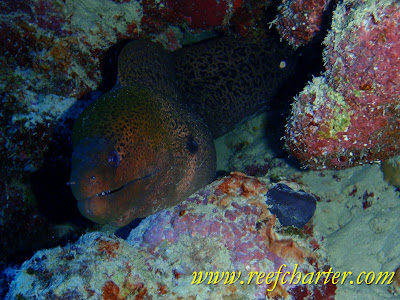There are over 200 different types of Moray Eels around the world, living in a number of different environments. The smallest moray is about 12cm (5 inches) and the longest is about 4m (13 feet) long. The largest variety of the species being found in warm tropical waters and reefs with diversity lessening as the water becomes cooler.
The Moray Eel relies on camouflage and smell to catch its food as it has relatively poor eyesight. It lies in crevaces and waits for its next meal to swim past. To assist with hiding even the inside of the mouth is coloured to fit in with its surroundings. This also allows the moray to lie in waiting with its mouth open to get little warning to the unsuspecting prey. The moray eel also has a second set of jaws that move forward when attacking and give the eel some extra grip on the prey. This second set of jaws also help pass the food down to the stomach of the ray.
There are only a few predators of the moray eel, they include the barracuda, Groupers, Sea Snakes and other Moray Eels. The Moray itself is carnivorous and eats just about anything.
The Morays have sometimes been described as vicious or ill-tempered, this is not a deserved reputaiton as Morays hide from humans and would rather flee than fight. Morays are shy and secretive, and attack humans only in self-defense or mistaken identity (for example, a finger placed in a crevice where a moray resides may resemble a prey-item). Most attacks involve accidental bites during human-initiated interaction.

